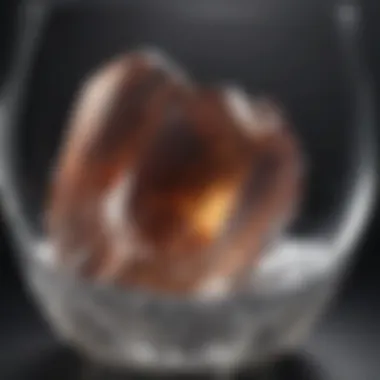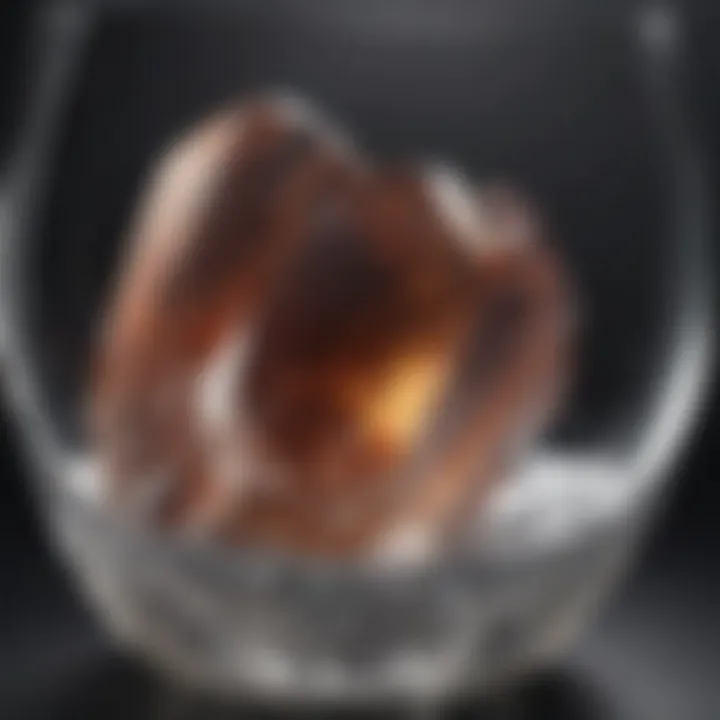The Essential Guide to Tumblers for Crystals


Intro
The world of crystal collecting is rich and diverse, encompassing a wide range of practices and approaches. Among these, the role of tumblers is often overlooked despite their importance in the collecting and preservation processes. Tumblers serve essential functions, enhancing the visual appeal of crystals while ensuring their longevity. This article will take a closer look at the significance of tumblers, their various types, and best practices for usage. By understanding these facets, collectors can make informed decisions and truly appreciate their collections.
History and Origins
Overview of Collectibles, Rocks, and Fossils
The practice of collecting rocks and fossils dates back centuries, with roots in ancient civilizations that valued these natural treasures. Tumbling, a technique that polishes stones to enhance their aesthetic qualities, has its origins in these early collecting practices. The evolution of tumblers reflects advances in technology and the growing appreciation for minerals and fossils.
Historical Significance and Cultural Impact
Over the years, tumblers have played a crucial role in how collectors interact with their items. Before mechanical tumblers became available, collectors often resorted to manual polishing methods, which were labor-intensive and often inconsistent. The introduction of electrically powered tumblers in the 19th century revolutionized the field, allowing collectors to achieve uniform results more efficiently.
Moreover, tumblers not only serve collectors but also have been embraced by various cultures. In many regions, polished stones are intertwined with local customs and crafts, further emphasizing their role in cultural identity.
Functionality and Types of Tumblers
Importance of Tumblers in Crystal Collecting
Tumblers function to smooth and polish the surface of crystals, enhancing their features and increasing their market value. During the tumbling process, crystals are subjected to a mixture of abrasives and water, creating a consistent polishing effect. This functionality is crucial for collectors committed to maintaining the best presentation of their rocks.
Types of Tumblers
When considering which tumbler to use, it is imperative to understand the various types available. Different machines are designed for specific needs, and the choice can greatly impact the results:
- Vibratory Tumblers: Utilize vibration to move the rocks and media within the chamber. These are often faster but may require more delicate handling of softer stones.
- Rotary Tumblers: Employ a rotating action and are best for longer tumbling processes. They are better suited for harder stones, providing a thorough polish.
- Barrel Tumblers: Often used in combination with rotary or vibratory functions, these tumblers can accommodate larger batches of stones.
Best Practices for Tumbling Crystals
Step-by-Step Tumbling Process
- Select Crystals: Choose stones based on their hardness and compatibility.
- Prepare the Tumbler: Ensure the tumbler is clean and assemble all necessary materials, including water and abrasives.
- Begin Tumbling: Fill the tumbler with stones, water, and abrasive grit, then start the machine.
- Monitor Progress: Check the outcome at regular intervals and adjust as necessary.
- Final Polish: After the primary cycle, run a final polish cycle to achieve that sparkling finish.
Tips for Maintaining Crystals During Tumbling
- Avoid overloading the tumbler, as this can prevent adequate polishing.
- Use appropriate grits for your specific stones to prevent damage.
- Regularly inspect the crystals to ensure they are not chipping or breaking under the pressures of tumbling.
"Understanding tumblers and their use is vital in preserving the beauty and value of crystals."
Finale
Tumblers occupy an essential niche in the realm of crystal collecting. They not only optimize the visual aspects of a collection but also contribute to the preservation of these natural items. Knowing the history, functionality, and best practices surrounding tumbling will empower both novice and experienced collectors. With this knowledge, anyone can enhance their collection and appreciate the intricacies of their gems.
Understanding Tumblers for Crystals
The act of collecting crystals involves a deeper appreciation of their inherent beauty and uniqueness. Tumblers serve a crucial function in this practice, as they can enhance the appearance and longevity of these gems. Understanding tumblers is important because they allow collectors to mold and shape the crystals, ensuring that they remain visually appealing and structurally intact over time. The tumbling process can bring out the colors and patterns of the crystals, making them truly shine.
What is a Tumbler?
A tumbler is a device specifically designed to polish and refine the surface of rocks and crystals. These machines work through a mechanical process that simulates the natural environmental effects of erosion. Tumblers come in various types and sizes, tailored to different needs and preferences. The basic operation involves placing the crystals, along with a certain type of abrasive material, into a rotating barrel. As the barrel turns, the crystals collide with each other and the grit, resulting in a polished finish.
Tumblers can generally be categorized into vibratory and rotary types. Vibratory tumblers shake the material in a back-and-forth motion, whereas rotary tumblers revolve the contents around a circular path. Both types serve the purpose of improving surface texture but differ in operation and time required for effective results.
Purpose of Tumblers in Crystal Care
The ultimate goal of using tumblers for crystal care encompasses several factors. Firstly, tumblers help in removing blemishes and rough edges. Crystals naturally come with irregularities, which can detract from their beauty. A tumbler smooths these rough surfaces, highlighting the crystal's natural features.
Secondly, tumbling can amplify visual appeal. The process brings out the natural colors and patterns of each crystal, making them more vibrant and attractive for display. Many collectors seek to enhance the aesthetic qualities of their specimens, making tumbling an invaluable practice.
Moreover, tumblers can facilitate preservation. Proper care and polishing extend the lifespan of crystals, preventing wear and tear from oxidation or environmental factors. With the right maintenance, collectors can ensure that their treasures remain pristine for years.
In summary, understanding tumblers not only equips crystal enthusiasts with the knowledge to improve their collections but also promotes a deeper respect for the stones themselves.
Types of Tumblers for Crystals
The section on types of tumblers is significant in understanding the different approaches to crystal care. Each tumbler type serves specific needs, leading to distinct outcomes in the tumbling process. Collectors often choose a tumbler based on their objectives, whether for aesthetic enhancement or preservation of mineral integrity. The careful selection of a tumbler can greatly affect the finish and quality of the crystals being treated.


Vibratory Tumblers
Vibratory tumblers work by creating rapid vibrations that lead to the agitation of crystals and grit. This type of tumbler generally has a straightforward design and operates with smaller amounts of grit, allowing faster processing times. One key benefit of vibratory tumblers is their efficiency. They can polish stones in significantly less time compared to rotary tumblers.
When using a vibratory tumbler, it is important to monitor the progress closely. Crystals can become shiny quite quickly. However, they may not achieve the same roundness that rotary tumblers can provide. This is relevant for collectors interested in the touch and look of their crystal specimens. It's wise to consider the specific attributes of the stones being tumbled.
Rotary Tumblers
Rotary tumblers operate by rotating the barrel containing the crystals and grit. This continuous motion creates a more uniform finish on stones, making it ideal for collectors seeking a polished texture. Rotary tumblers usually take longer than vibratory tumblers but, in return, offer a more thorough polishing ability. The slowing process can result in softer stones achieving a deep luster.
Choosing a rotary tumbler often comes down to the size of the load and the desired output. Larger barrels can handle a bulk of crystals at once, which is beneficial for collectors with extensive collections. However, they also require more time and may produce rougher finishes on sensitive stones if not handled properly. As such, attention to detail is essential in selecting this type of tumbler.
Wet vs. Dry Tumbling
The choice between wet and dry tumbling methods plays a crucial role in the outcome of crystal processing. Wet tumbling uses water to facilitate the grit and lessen friction. This method helps reduce dust and can prevent damage to softer stones, providing a smoother finish. Wet tumbling is often preferred for delicate minerals like opals and fluorites, which can suffer from extensive surface scratches if tumbled dry.
On the other hand, dry tumbling employs a dry grit mixture. This method can be more abrasive and efficient in certain applications. It is also suitable for harder stones that can withstand more rigorous processes. However, dry tumbling typically requires more careful monitoring to avoid damaging the crystals.
Understanding the nuances of wet and dry tumbling helps collectors make informed decisions, especially depending on the types of crystals in their collection. Ultimately, selecting the right tumbler enables enthusiasts to preserve their collections while enhancing their aesthetic appeal.
"The choice of tumbler profoundly influences the character and value of the crushed minerals."
Balance in this decision will aid in achieving optimal results, ensuring that collectors retain the beauty and integrity of their crystals.
Selecting the Right Tumbler
Choosing the appropriate tumbler is crucial for crystal collectors, as it greatly influences both the quality of the finishing process and the overall preservation of the specimens. Factors like materials, size, and capacity play significant roles in ensuring that crystals are properly tumbled without risking damage. Selecting the right tumbler can enhance not just the aesthetics of your collection but also the durability of your crystals over time.
Material Considerations
When selecting a tumbler, the material used in its construction is a key factor. Tumblers can be made from various materials, such as plastic, metal, or rubber, each with specific benefits and drawbacks.
- Plastic Tumblers: Generally lightweight and more affordable, plastic tumblers are suitable for beginners. However, they may wear down faster with frequent use and might not provide the desired level of durability.
- Metal Tumblers: Often more robust than their plastic counterparts, metal tumblers can handle heavier loads and last longer. Stainless steel is a popular choice for its corrosion resistance and strength.
- Rubber Tumblers: These are designed for quiet operation and can minimize noise during use. They are ideal for indoor use where sound could be an issue.
Ultimately, the choice of material also depends on the intended use and frequency of tumbling. If you are a serious collector, investing in a high-quality metal tumbler may yield better results over time.
Size and Capacity
Size and capacity are additional important aspects to consider. The right tumbler should accommodate the volume of crystals you intend to process while allowing enough space for movement during tumbling.
- Smaller Tumblers: These are easier to manage and require less workspace. They may be a good option for hobbyists or those who have a limited collection. However, they may not be suitable for larger stones or multiple pieces at once.
- Larger Tumblers: A larger capacity tumbler can process more material at one time, which is beneficial for collectors who have extensive collections. Nonetheless, larger tumblers may require more power and take up additional space.
Carefully assessing your collection's size and your specific tumbling needs will help you make an informed decision about which tumbler will serve you best. Collectors should also consider how often they plan to use the tumbler; more frequent use may warrant a larger machine for efficiency.
Selecting the right tumbler is essential to maximizing the lifespan and beauty of your crystals, ensuring optimal processing without jeopardizing their integrity.
Operational Insights
In the context of crystal tumbling, operational insights play a vital role in optimizing the effectiveness of tumblers. Understanding how to properly operate a tumbler ensures that the crystals achieve their desired finish without incurring unnecessary damage. Collectors benefit from grasping these operational details, as it directly correlates to the longevity and aesthetic appeal of their crystal specimens. Moreover, effective operational strategies can lead to more predictable outcomes, allowing enthusiasts to refine their techniques over time.
Loading the Tumbler
Loading the tumbler correctly is a foundational step for successful tumbling. It is essential to follow a few key principles to maximize efficiency:
- Balance: Ensure that the load is balanced. Uneven distribution can lead to excessive vibrations or potential damage to the tumbler itself.
- Separation: Avoid overcrowding the tumbler. Crystals need space to move freely, allowing the tumbling grit to wear down their surfaces effectively. A crowded tumbler will lead to ineffective polishing and may cause fractures or chips.
- Variety in Size: Including crystals of varying sizes can help achieve better results, as smaller stones can fill gaps between larger ones, promoting movement and effective tumbling.
It is also vital to check that the tumbler’s barrel is clean before loading. Residual grit from previous runs can contaminate the current batch, altering its effectiveness.
Understanding Tumbling Grits
Tumbling grits are critical to the tumbling process, each with a specific purpose. Here are the primary types that collectors should be aware of:
- Coarse Grit: This is often the first stage in tumbling. Coarse grits help in removing any sharp edges and imperfections on the stones. Typical options include 60/90 silicon carbide.
- Medium Grit: Following the coarse stage, medium grits refine the surface further. This is where smoother finishes begin to form. Common mediums include 120/220 silicon carbide.
- Fine Grit: For polishing, fine grits improve the shine and luster of the crystals. Aluminum oxide is often used at this stage, providing enhanced clarity.
- Tumbling Compounds: In addition to grits, certain compounds can be added for specific effects, such as waxes or polishing powders, which yield superior shine.
Understanding how to effectively utilize and transition between these grits is essential. Each stage requires careful monitoring of the tumbling time, as over-tumbling can lead to damaging effects on the crystals.
Effective tumbling is a blend of science and artistry: attention to detail can transform ordinary crystals into extraordinary pieces.


Best Practices for Crystal Tumbling
Tumbling crystals is both an art and a science. To achieve the best results, it is crucial to follow best practices during the tumbling process. These practices not only enhance the aesthetics of the crystals but also ensure their long-term preservation. Collectors must pay attention to detail, as even minor deviations can lead to unsatisfactory outcomes. Here are some key aspects to consider when tumbling crystals effectively.
Monitoring Tumbling Progress
Monitoring the tumbling progress is vital to understanding how the process is affecting your crystals. This can help you determine when to switch grits or when to end the tumbling session altogether. Regularly checking on your crystals will provide insight into the changes occurring and ensure that you achieve the desired finish.
- Frequency of Checks: Depending on the type of tumbler used, check the crystals every few hours. This can avoid over-processing which may lead to unwanted wear.
- Visual Assessment: Look for shine or smoothness developing on the crystal surface. Noticing these changes can alert you to adjust the processing time or grit.
- Sound Check: Pay attention to the sound during tumbling. A change in noise can be an indicator that the crystals are either tumbling effectively or encountering issues.
By attentively observing these elements, collectors can make informed decisions throughout the tumbling process, leading to consistently pleasing results.
Cleaning and Maintenance
Cleaning and maintenance of both the tumbler and the crystals are crucial for optimal performance. Any debris, leftover grit, or contaminants can interfere with the tumbling process. Therefore, proper care must be taken before and after each tumbling session.
- Tumbler Care: Regularly clean your tumbler to avoid residue build-up. This includes rinsing out gritty materials and wiping down internal parts.
- Crystal Cleaning: Wash the crystals thoroughly before placing them in the tumbler. This helps to eliminate any dirt or oils that could affect the tumbling process.
- Mid-Process Maintenance: If you notice a build-up of grit or residue during operation, it may be wise to pause and clean out the tumbler before continuing.
Regular maintenance not only prolongs the life of your tumbler but also enhances the quality of the finished crystals.
Implementing these best practices will lead to an improved tumbling experience. This attention to detail allows collectors to preserve their crystals while enhancing their beauty through the tumbling process.
Advantages of Using Tumblers
The use of tumblers in the realm of crystal collecting presents distinct advantages that go beyond mere aesthetics. Tumblers provide a method for effectively polishing, cleaning, and preparing crystals for display or sale. For collectors, understanding these benefits is crucial not just for the enhancement of their collections, but also for preserving the integrity of the specimens. This section will explore two critical advantages: enhanced aesthetics and increased value of crystals.
Enhanced Aesthetics
One primary benefit of using tumblers is the enhancement of crystal aesthetics. Tumbling can significantly improve the visual appeal of crystals, making them more attractive to both collectors and casual observers. The tumbling process refines the surfaces of the crystals, which in turn can amplify their natural colors and features.
By utilizing tumblers, collectors can achieve a smoother and shinier finish. This is particularly notable for rough specimens that may lack luster or vibrancy. The polishing action not only eliminates minor scratches and imperfections but can also enhance the translucence of certain types of rocks. These aesthetic improvements can make a significant difference when showcasing a collection.
Furthermore, the appeal of visually striking specimens can lead to better presentation in exhibitions or sales. Crystals with bright, polished surfaces tend to attract more attention. This consideration is paramount for any collector aiming to impress or educate others about their collections.
Increased Value of Crystals
Another aspect worth examining is how tumbling impacts the value of crystals. The condition and appearance of a crystal play a vital role in its market value. Well-maintained and polished specimens typically command higher prices in the collecting community.
When collectors use tumblers, they effectively invest in the preservation and enhancement of their stones. Polished crystals often fetch higher prices at auctions or when sold in the market, thus improving the financial return on investment for collectors.
Moreover, tumblers can help maintain the structural integrity of delicate specimens. For instance, some crystals have fragile points that can be damaged over time. A controlled tumbling process can help ensure these pieces remain intact while improving their aesthetic.
Ultimately, the combination of visual enhancement and increased value makes the use of tumblers a wise choice for those serious about crystal collecting.
The careful use of tumblers can transform rough gemstones into dazzling works of art, ensuring collectors showcase the best of what their collections have to offer.
Challenges and Limitations
The use of tumblers in crystal care is not without its challenges and limitations. Understanding these factors is crucial for collectors who wish to preserve the integrity of their specimens while maximizing the benefits of tumbling. By acknowledging potential pitfalls, enthusiasts can make informed decisions that safeguard their collections. In this section, we will explore common issues with tumbling and the inherent risks associated with crystal treatment.
Common Issues with Tumbling
One of the foremost challenges encountered in tumbling is inconsistent results. It's quite common for some crystals to emerge beautifully polished, while others may end up dull or improperly shaped. This inconsistency can arise from several factors:
- Material Variety: Different crystals have unique hardness levels and compositions, which affect how they respond to tumbling.
- Grit Quality: Using subpar tumbling grit can lead to unsatisfactory polishing results. It's critical to select high-quality materials appropriate for the specific crystals being treated.
- Time Management: Over or under-tumbling can cause damage. Each crystal requires a unique tumbling duration to achieve optimal results.
"Proper timing is essential to achieving the ideal finish for crystals. Neglecting this aspect can lead to irreversible damage."
Moreover, shape alterations during the tumbling process can occur. Crystals may lose their natural form if too much material is removed. Collectors should consider their tolerance for modifications before placing a crystal in a tumbler.
Understanding Risks to Crystals
The tumbling process imposes certain risks that every crystal collector should comprehend. One major concern is damage to brittle specimens. Some crystals, such as selenite, are notably fragile. Even minor impacts during tumbling can lead to cracks or chips, permanently affecting their visual appeal.
- Crystal Integrity: Each crystal has a distinctive structure that can be disrupted through tumbling too aggressively. Hence, it's paramount to assess the durability of each specimen.
- Chemical Reactions: If wet tumbling, using water or additional additives can provoke unwanted reactions. Some softer stones may dissolve or lose color with certain chemicals, resulting in loss of value.
- Contamination Risks: Mixing different crystal types during tumbling can lead to contamination. The hardness and shape of other crystals may cause abrasions on softer specimens, compromising their appearance.
In summary, while tumblers can significantly enhance the visual appeal and perceived value of crystals, they are not foolproof. A sound understanding of the challenges and limitations in crystal tumbling enables collectors to make prudent choices, ultimately enriching their collection while minimizing risks.


Historical Context of Tumblers
The use of tumblers in the context of crystal collecting and preservation carries significant historical weight. Understanding their origins and the technological advancements that have shaped their development not only informs collectors about their practical applications but also enriches the appreciation of this craft. Knowledge of history allows collectors to engage with their specimens on a deeper level, connecting them to the broader narrative of geological study and mineral preservation.
Origination of Crystal Tumbling
Crystal tumbling traces its roots back to ancient practices where the desire to refine and enhance the natural appearance of stones became evident. Early civilizations, such as those in Mesopotamia and ancient Egypt, realized that smooth, polished stones could not only serve practical purposes but also aesthetic ones. They often used rudimentary methods involving sand and rough stones to achieve a polished finish.
This practice slowly evolved through centuries of trial and error. By the 19th century, the art of tumbling became more systematic with the introduction of machine technology. Small-scale operations began to emerge, allowing hobbyists and professionals alike to improve both the quality and consistency of their polished stones. The introduction of rotary tumblers marked a pivotal moment, enabling greater control over the tumbling process, which could yield superior results for collectors.
Evolution of Tumbler Technology
The evolution of tumbler technology reflects broader advances in mechanical engineering and materials science. Early tumblers were often made from wood or metal, constraining their durability and effectiveness. With the emergence of synthetic materials, manufacturers began to produce tumblers equipped with more robust components that could endure the rigors of extensive use.
In the late 20th century, vibratory tumblers were introduced. These devices operate on a different principle, creating motion that separates the stones and leads to more uniform polishing. The development of specialized tumbling grits and media has also significantly improved the process. Various compounds allow users to customize their approaches depending on the type of crystal and desired finish.
Modern tumblers not only provide improved efficiency but also minimize the risk of damaging delicate specimens, making them essential tools for contemporary collectors.
As technology continues to advance, it is crucial for collectors to remain aware of these developments. Knowledge of the history and evolution of tumblers fosters an appreciation not only for the tools themselves but also for the craftsmanship that goes into preserving these natural wonders.
The Community of Crystal Enthusiasts
The community of crystal enthusiasts plays a vital role in the sphere of crystal collecting and preservation. Collecting crystals is not just a solitary endeavor; it invokes a sense of belonging and shared passion among like-minded individuals. These communities are platforms for exchange and support, fostering a greater understanding of the nuances related to the care and enhancement of crystal collections.
Members often share their personal experiences, challenges, and successes, which significantly contributes to the collective knowledge within the community. This collaborative approach promotes learning and encourages new collectors to develop their skills in a supportive environment. By participating actively, individuals can glean insights into best practices, including effective tumbling methods, care techniques, and even the historical significance of various specimens.
Moreover, tapping into these networks allows enthusiasts to discover rare finds, trade and sell crystals, and stay updated on new discoveries in the field. As this happens, it strengthens bonds within the community and enriches the collective experience of all members.
Collaborative Knowledge Sharing
Collaborative knowledge sharing is a cornerstone of the crystal enthusiast community. Through various platforms such as forums, social media groups, and local clubs, collectors can solicit advice and share insights on various topics. Often, experienced collectors take the time to mentor novices, guiding them through critical processes such as selecting the right tumbler or understanding the implications of different tumbling techniques.
Discussions can revolve around:
- Specific types of tumblers and how they affect different crystals
- Tumbling grits and the progression necessary for optimal results
- Best practices for monitoring and evaluating crystal condition during the tumbling process
This not only fosters a sense of camaraderie but also helps elevate the overall knowledge base of the participants. Engaging in collaborative knowledge sharing can lead to innovation in practices, providing enthusiasts with new ideas on how to enhance their collecting experience.
Events and Exhibitions
Events and exhibitions serve as a powerful mechanism for the community to come together. Such gatherings allow enthusiasts to showcase their collections, trade specimens, and participate in educational workshops designed to deepen their knowledge. These events can range from local meet-ups to larger conventions that feature vendors, experts, and speakers from across the globe.
During these events, attendees often engage in:
- Demonstrations on tumbling techniques
- Discussions on the latest advancements in crystal care
- Networking opportunities to build relationships with other collectors and suppliers
Events also offer a platform for awareness regarding preservation ethics and methods in the crystal collecting world. Bringing the community together fosters not only a support network but also a shared vision for the future of crystal collection and awareness of its environmental impact.
Gathering with fellow enthusiasts magnifies the learning experience, allowing us to explore and discover more about the world of crystals than we could alone.
Epilogue
The role of tumblers in crystal collecting is pivotal and multifaceted. As the article has outlined, tumblers are not mere tools; they are essential in fostering the proper care and enhancement of crystals. Their significance extends beyond aesthetics to the preservation of the unique characteristics of each crystal. A collector's choice of tumbler can lead to not only polished, visually appealing crystals but also contribute to the durability and value of their collection.
In this article, we explored the intricacies of different tumbler types, operational insights, and best practices tailored specifically for crystals. Each element discussed serves a dual purpose: to educate collectors on choosing and using these equipment effectively, while also highlighting the importance of proper techniques to mitigate potential damage to the crystals.
Considerations regarding material selection and size are equally crucial, as the wrong tumbler might not only yield subpar results but also jeopardize the integrity of the crystals. Moreover, understanding common challenges and technological advancements is vital for ensuring a collector's success. The historical context provided insight into how tumblers have evolved, emphasizing their growing importance in the field.
Lastly, we delved into the community aspect of crystal collecting. By participating in forums and exhibitions, collectors can share knowledge, further enhancing their skills and experiences. This collective growth is beneficial for both novices and seasoned experts.
In summary, the conclusion drawn from this article reinforces that tumblers are not just optional tools but integral to the art and science of crystal collecting. The informed application of tumblers can vastly improve not just the visual appeal, but also the long-term preservation of crystals. Understanding these dynamics allows collectors to make educated choices, contributing to the depth and quality of their collections.
"A well-selected tumbler not only polishes crystals but also protects their true essence."
Final Thoughts on Tumblers for Crystals
In essence, tumblers represent a unique intersection of technology and artistry in the world of rock and crystal collecting. As previously emphasized, the choice of tumbler should align with the specific needs of the collector's pursuits. Some enthusiasts may prioritize a vibratory tumbler due to its efficiency, while others might prefer a rotary tumbler for its gentler approach.
Key aspects to consider include:
- Material quality: A durable tumbler assures longevity and consistent results.
- Tumbling techniques: Knowledge of proper grit usage, monitoring, and maintenance can significantly affect outcomes.
- Community engagement: Sharing insights and techniques with fellow enthusiasts can enhance one's understanding and enjoyment of the process.
Ultimately, tumblers serve a vital role in both enhancing the beauty of the crystals and ensuring their preservation. Engaging with tumblers thoughtfully opens a pathway to more profound appreciation and care for the natural wonders one seeks to collect.



